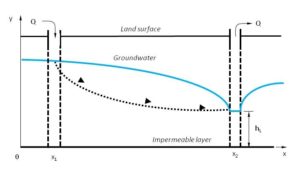Application of managed aquifer recharge can have a positive or negative effect on other groundwater users, such as production wells or natural springs. The effects that MAR may have on other groundwater users need to be identified and quantified .
Assessment of the impact of implementation of managed aquifer recharge on the local and regional groundwater systems and its users is of vital importance. Though the effects of MAR are generally thought to be positive by raising groundwater levels and thus ensuring continuous water supply for nearby wells or springs, an exaggeration of situation can lead to superelevated groundwater levels that may cause waterlogging or overflowing wells. It further needs to be checked if ASR wells affect surrounding groundwater users during the recovery phase when the groundwater table might be significantly lowered.

Figure 1. Determination of influence of newly implemented ASR well at position x1 with already existing production well at position x2
With the help of a regional groundwater model the impact of MAR as a new groundwater use on traditional groundwater users was assessed in Australia (Martin et al., 2012). Modeling the changing situation was of assistance to adjust water allocation plans for the area. In Florida the effects of ASR well fields on existing pumping wells was determined by modeling in order to optimize the well field design and operational parameters (Brown and Nevulis, 2006).
The INOWAS DSS can help to identify whether a MAR site lies within the vicinity of other groundwater users and if so, which effect the application of MAR on said users will have. The following INOWAS tools can be used to assess the impact of MAR on other groundwater users:
- T03. MODFLOW model setup and editor
- T07. MODFLOW model scenario manager
- T13. Travel Time Through Unconfined Aquifer
To select a suitable MAR method or a model set for the specific study area, the following tools can be used:
REFERENCES
- Brown, C.J., Nevulis, R., 2006. A model study of the proposed Everglades Restoration Hillsboro ASR Pilot Project, in: UNESCO (Ed.), Recharge Systems for Protecting and Enhancing Groundwater Resources – Proceedings of the 5th International Symposium on Management of Aquifer Recharge ISMAR5, Berlin, Germany, 11–16 June 2005, ISMAR Proceedings. pp. 73–78.
- Martin, R., Barnett, B., Pitman, C., Kaufmann, C., Swiatnik, A., Burgess, C., 2012. Modelling the regional impacts of multiple MAR schemes on the Northern Adelaide Plains, in: Draeger, M. (Ed.), Achieving Groundwater Supply Sustainability & Reliability through Managed Aquifer Recharge – Proceedings of the Symosium ISMAR 7, 9-13 October 2009, Abu Dhabi, UAE. Abu Dhabi, UAE, pp. 389–397.
